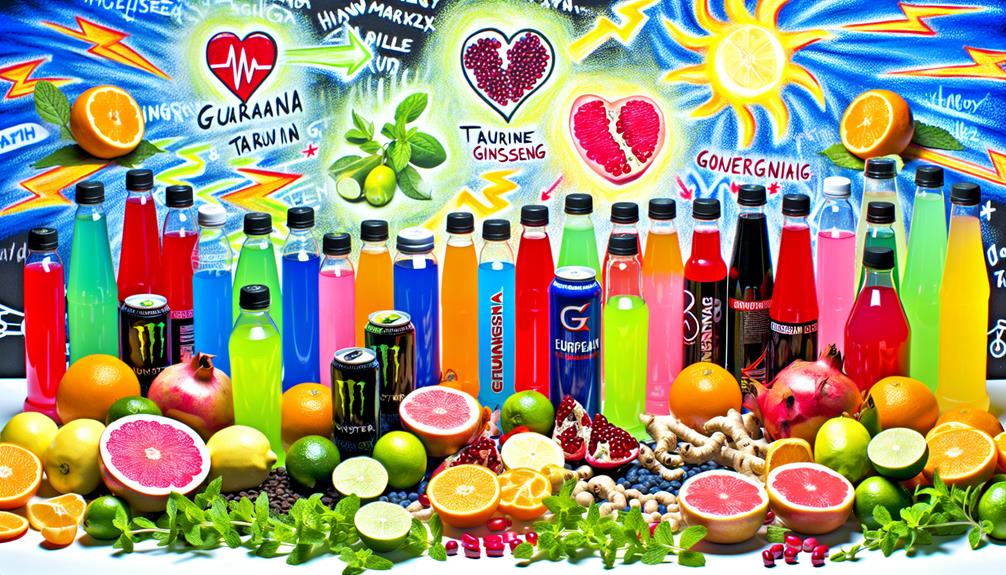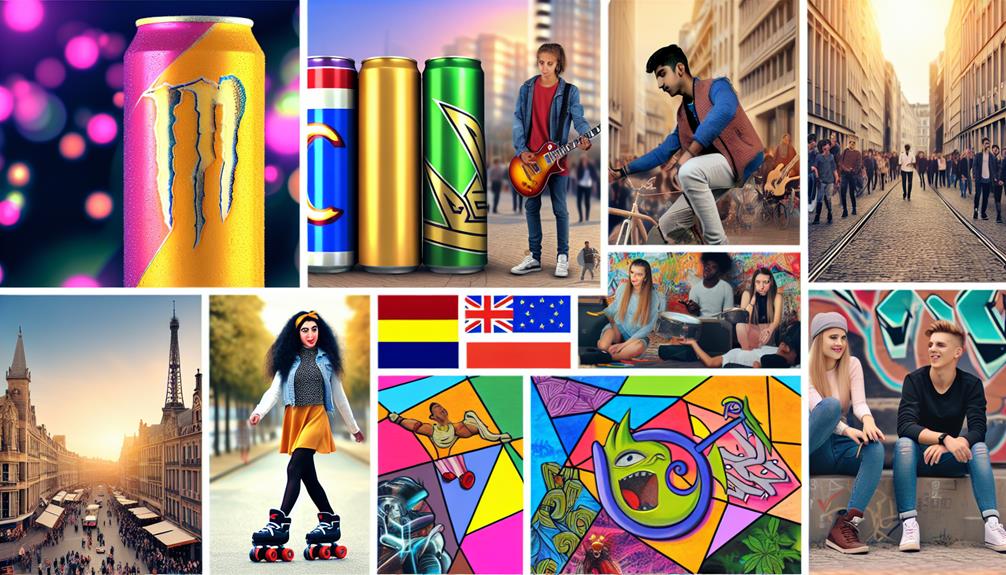Much like the mythical fountain of youth, the allure of European energy drinks seems irresistible, promising energy and vigor. You might've noticed how brands like Red Bull and Monster have carved out their niches, but what's behind their meteoric rise? The cultural nuances across Europe reveal intriguing contrasts in consumption patterns, and as health trends shift, so do consumer expectations. Are these beverages merely a trend, or is there more to their appeal than meets the eye? Let's explore the layers that shape this dynamic market.
History of Energy Drinks in Europe
The history of energy drinks in Europe is a fascinating journey that reflects changing consumer needs and cultural attitudes towards caffeine and stimulants. The market evolution began in the late 20th century, primarily driven by the rise of performance-oriented lifestyles. Initially, energy drinks were marketed towards athletes and those seeking an energy boost for physical activities. You'll see brands like Red Bull, which entered the European market in the 1980s, greatly influenced consumer perceptions of energy drinks as essential tools for enhancing performance.
As you explore deeper into this history, you'll notice regional preferences playing a vital role in shaping the market. For instance, in Northern Europe, energy drinks have often aligned with extreme sports and outdoor activities, while in Southern Europe, the focus has been more on social settings and nightlife. This divergence illustrates how cultural attitudes can dictate product positioning and marketing strategies.
Popular Brands and Flavors
As energy drinks gained traction in Europe, a diverse array of brands and flavors emerged, catering to the varied tastes and preferences of consumers. The market's evolution shows significant brand comparisons that highlight the competitive landscape. Leading brands like Red Bull, Monster, and Rockstar dominate, but niche players like Lucozade and Isotonic are carving their own paths by focusing on unique offerings.
When it comes to flavor innovations, brands have had to stay ahead of the curve to attract consumers. Classic flavors like citrus and berry remain popular, but there's been a noticeable shift towards more exotic options. For instance, brands are experimenting with tropical fruit blends, herbal infusions, and even dessert-inspired flavors such as vanilla cream and chocolate. This trend not only reflects consumer demand for new experiences but also the impact of cultural influences across Europe.
Market research indicates that consumers are increasingly interested in low-sugar and natural options, prompting brands to innovate further. For example, drinks sweetened with stevia or those fortified with vitamins and electrolytes are gaining traction. This shift is indicative of a broader trend in consumer behavior focused on health and wellness, even within the energy drink category.
Ultimately, the landscape of popular energy drink brands and flavors in Europe is dynamic and continuously evolving. By analyzing brand comparisons and flavor innovations, you can better understand what drives consumer choices in this competitive market, and how these elements shape the future of energy drinks.
Key Ingredients and Health Effects

Examining the key ingredients in European energy drinks reveals a complex interplay between performance enhancement and health considerations. At the forefront, caffeine serves as the primary stimulant, sourced from various origins like coffee beans, tea leaves, and synthetic compounds. This diversity in caffeine sources can considerably affect how your body absorbs and responds to the drink. For instance, natural caffeine sources often come with additional antioxidants, potentially offering extra health benefits.
In addition to caffeine, many energy drinks include herbal additives, such as guarana and ginseng. Guarana, a common ingredient, contains caffeine itself, enhancing the overall stimulant effect. Ginseng is often touted for its ability to boost energy and improve mental performance. However, while these herbal additives can provide benefits, they may also introduce risks, particularly if consumed in excess.
Research indicates that excessive caffeine intake can lead to adverse effects including anxiety, insomnia, and increased heart rate. Remarkably, the combination of high caffeine levels with other stimulants found in herbal additives can amplify these risks, making it vital for you to monitor your total intake.
Ultimately, while energy drinks can enhance alertness and physical performance, understanding the key ingredients and their potential health effects is essential for making informed choices. Balancing performance enhancement with health considerations can help you navigate the complex landscape of European energy drinks more safely.
Regulations and Safety Standards
Regulations surrounding energy drinks in Europe are designed to guarantee consumer safety amid the rising popularity of these products. The European Union (EU) has established stringent labeling requirements to ensure that consumers are fully informed about the contents of the drinks they consume. For instance, energy drinks must clearly state the caffeine content, and any other stimulants must be listed, allowing you to make informed choices. The labeling also mandates warnings about excessive consumption, which is essential given the potential health risks associated with high caffeine intake.
Additionally, import restrictions play a significant role in maintaining safety standards. The EU imposes rigorous checks on imported energy drinks to ensure they comply with local regulations. These restrictions help prevent products that don't meet established safety standards from entering the market. For example, any energy drink containing prohibited substances or exceeding specific caffeine limits is automatically barred from import.
Data from the European Food Safety Authority (EFSA) indicate that these regulations have resulted in a marked reduction in health-related incidents tied to energy drink consumption. By enforcing strict guidelines on both labeling and imports, the EU aims not only to protect consumers but also to promote responsible consumption practices. As a consumer, being aware of these regulations is critical, as it empowers you to make safer choices when selecting energy drinks in the marketplace. The ongoing evolution of these regulations reflects a proactive approach to public health in a rapidly changing beverage landscape.
Cultural Impact and Trends

Energy drinks have increasingly woven themselves into the fabric of modern European culture, particularly among younger demographics seeking an extra boost for their busy lifestyles. As you navigate through bustling cities or attend late-night events, you'll likely notice energy drinks being consumed more frequently, reflecting both a societal trend and a shift in consumption patterns.
- The market for energy drinks in Europe is projected to reach €16 billion by 2025.
- 70% of energy drink consumers are aged 18-34, highlighting youth engagement.
- Marketing strategies emphasize vibrant branding and social media outreach, driving consumer interest.
This demographic's energy drink consumption is not merely about caffeine intake; it's connected with lifestyle choices and social interactions. The clever marketing strategies employed by brands, often targeting energetic and adventurous lifestyles, have successfully resonated with young adults. Campaigns that utilize social media influencers and sponsorship of sports events have further cemented energy drinks as a cultural staple.
Moreover, the association of energy drinks with an active lifestyle creates a perception of necessity in managing the pressures of modern living. However, it's important to be mindful of the implications of these trends. While the allure of energy drinks is clear, increased consumption has raised concerns about health and well-being, urging a need for informed choices. As you observe these shifts in cultural habits, consider the balance between enjoyment and responsibility in energy drink consumption.
Frequently Asked Questions
Are Energy Drinks Suitable for Children and Teenagers?
Energy drinks aren't suitable for children and teenagers due to potential health risks, such as increased heart rate and anxiety. Parental guidance is essential in educating youth about these dangers and promoting healthier alternatives.
Can Energy Drinks Cause Addiction or Dependency?
Energy drinks can create a slippery slope of dependency. As you build caffeine tolerance, missing your usual dose might lead to withdrawal symptoms, making it hard to break free from the habit. Awareness is key to moderation.
What Is the Caffeine Content in European Energy Drinks?
Caffeine content in energy drinks varies widely, typically ranging from 30 to 300 mg per serving. Understanding caffeine sources helps you gauge potential energy levels, enabling informed choices about your consumption and overall health impact.
How Do Energy Drinks Compare to Coffee for Energy Boosting?
When you sip an energy drink, its ingredients rush in, promising quick energy. Compared to coffee, energy drinks often have faster caffeine absorption, but they may not sustain your energy as effectively over time.
Are There Any Natural Alternatives to Energy Drinks Available in Europe?
You'll find natural alternatives like herbal supplements and beverages made from natural ingredients, such as green tea or yerba mate. They offer sustained energy without the jitters, making them a healthier choice compared to typical energy drinks.
Conclusion
In examining the evolution of European energy drinks, you might wonder if their rise is truly linked to lifestyle changes or merely marketing hype. Data shows that as health trends grow, so does the demand for innovative, functional beverages. While brands adapt to cultural nuances across Europe, it's important to recognize the impact of regulations ensuring safety. Ultimately, understanding these dynamics helps you navigate your choices in a market that's as energized as its consumers.